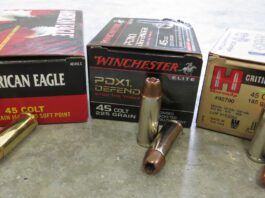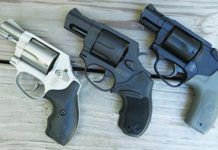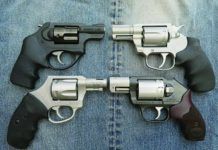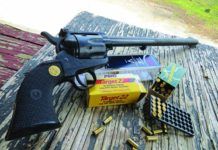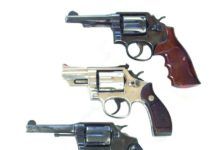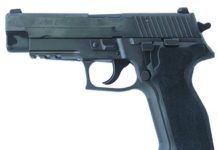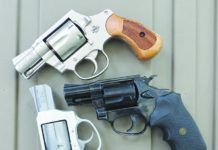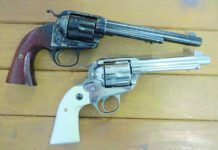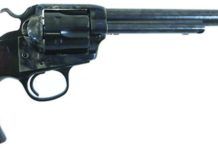First Look Video: New and Old Colt Pythons
New Snubnose Revolvers Under $400: S&W, Taurus Compete
Snubnose revolvers are viable options when deciding what type of self-defense firearm to purchase. They are easy to use and easy to conceal. Plus, the 38 Special cartridge is an excellent self-defense round, and 38 Special +P loads are almost as powerful as a 357 Magnum rounds. We procured three snubnose revolvers under $400 — the Smith & Wesson Model 637-2, Smith & Wesson M&P Bodyguard 38, and the Taurus Model 856 — to see which one would come out as top dog.
In our opinion, all three of these snubnose revolvers are good choices for concealed carry and home defense. All have attributes that make them well suited for conceal carry, such as light weight, small grips, and smooth, snag-free outside edges. Sights are a big consideration, and we like them large and easy to use, and if we have the ability to modify the sight, that is a plus in our book. The triggers also need to be smooth because these revolvers will mostly likely be fired in double-action (DA) mode. Plus, we think the ability to fire 38 Special and 38 Special +P ammo through the revolver enhances its versatility.
New Revolvers from Kimber, Charter Arms, Ruger, and Colt
Why are there so many snubnose revolvers being manufactured? There is no sign that big-bore snubnose revolvers are going away any time soon, especially with manufacturers introducing new snubnoses. Snubnose wheelguns have been and are still excellent choices for self-defense sidearms. Easy to use, no magazine to lose, and chambered in powerful calibers, revolvers are here to stay. So we took a look at four new snubnose revolvers: the Charter Arms Boomer, Ruger's LCRx, the Kimber K6s CDP, and the Colt Cobra. These snubnose revolvers all proved to be reliable, safe, consistent, and accurate for self defense. What we experienced with these revolvers was a variety of grip sizes, some of which our testers said were too small for comfortable shooting or they were too big for ideal concealed carry.
The sights on three guns were very serviceable, while one didn't have sights at all. The triggers separated the pack, as did the chamberings. Two used a double-action-to-single-action trigger and two featured a double-action-only (DAO) trigger. A revolver chambered in 357 Magnum offers convenience because it can shoot 38 Special ammo, too. After tallying the scores, in our opinion the Ruger LCRx is a good choice for concealed carry, though we would tweak it. The Charter Arms Boomer, Kimber K6s, and Colt Cobra are all pretty good choices, but as you will see, the devil is in the details on those three.
We tested at 10 yards because these snubnose revolvers are made for concealed carry and short-range encounters. But we learned 10 yards was too far if you don't have sights, so we accuracy tested the Charter Arms Boomer at 7 yards. Not having sights is a liability as the distance between you and a bad actor increases. Though we typically test at 25 yards, FBI data shows that most gunfights between an officer and an attacker occur from a distance of 0 to 5 feet apart. We concealed-carry citizens can expect the same. The reality is these revolvers are made for up-close work. Short sight radii, smallish grips, and DA triggers do not make for tack-driving accuracy.
We also carried these revolvers in inside-the-waistband (IWB) and appendix-carry-style holsters. We took the time to practice our draw and dry-fire these revolvers at an imagined bad actor a few steps away. On the range, we tested for accuracy using a rest. The DA/SA trigger mode on the LCRx and Colt provided an edge over the DAO models. We also tested a variety of ammunition, and the K6s and LCRx proved to be more practical and versatile because they can fire both 38 Special and 357 Magnum cartridges. Here's what we thought about each handgun in more detail.
A Trio of Unusual Revolvers: Worth the Trouble and Money?
Most gun owners want firearms they can shoot and have fun with, even their life-and-death carry guns. Some of us also want the unusual because we like a walk on the wild side, irrespective of whether it has any use beyond messing around with or plinking. In this Special Report, we take a look at three wheelguns for which there are little or no match ups to find, so head-to-head testing isn't possible. But even without something to shoot beside them, we can learn plenty about whether some unique, or nearly unique, handguns are worth the time and trouble to find and add to your collection as a real, firing item.
Herewith then, we look at the Nagant M1895 7.62x38mmR, the Smith & Wesson Model 929 9mm Luger, and the Chiappa Buntline 22 LR.
Used 38 Sp. Revolver Contest: Colt, Smith & Wesson, Ruger
Revolvers make excellent home-defense handguns. They are simple to use and reliable and will come up shooting after long periods of storage. There are no springs compressed when the revolver is loaded, and no magazines to keep up with. The revolver may be chambered for powerful and efficient cartridges, such as the 38 Special +P and the 357 Magnum. For shooters able to engage in only minimal training, the revolver makes a lot of sense. Conversely, many very experienced shooters trust the revolver and little else. The smooth-rolling double-action trigger helps avoid flinch and the rhythm, once learned, allows excellent hit probability.
We set out to find four used revolvers for this Bargain Hunter segment. They had to be high quality and chambered for either the 38 Special or 357 Magnum cartridge, with the emphasis on 38 Special. While most homeowners will load these revolvers with 38 Special ammunition, the 357 Magnum is certainly a viable option, so we tested the revolvers chambered for the Magnum cartridge with these heavy loads as well. Because we were looking for bargains, we limited the used cost to a maximum of $500 counter price. We found one revolver at that maximum and three for considerably less, including two revolvers at $300. We chose medium-frame revolvers for two of the handguns and small frames for the other two handguns.
Three were six-shot revolvers and one was a five-shooter. We elected not to pursue heavy-frame revolvers, such as the Smith & Wesson L frame or Ruger GP100, and we also did not look for J-frame type snubnose revolvers. Basically, we were looking for affordable houseguns that would do a credible job of home defense if called upon. The contenders were as follows
2016 Guns & Gear Top Picks
Toward the end of each year, I survey the work R.K. Campbell, Roger Eckstine, Austin Miller, Robert Sadowski, David Tannahill, Tracey Taylor, John Taylor, Rafael Urista, and Ralph Winingham have done in Gun Tests, with an eye toward selecting guns, accessories, and ammunition the magazine's testers have endorsed. From these evaluations I pick the best from a full year's worth of tests and distill recommendations for readers, who often use them as shopping guides. These choices are a mixture of our original tests and other information I've compiled during the year. After we roll high-rated test products into long-term testing, I keep tabs on how those guns do, and if the firearms and accessories continue performing well, then I have confidence including them in this wrap-up.
$400 Snubnose Revolvers: Rossi, RIA, and Charter Arms
We felt all of these were well made, and we believe these revolvers will perform their designed task of self defense. They are also safe to carry fully loaded and concealed, since they are equipped with internal safety systems that require the trigger to be pulled fully to the rear to fire a round. If accidentally dropped, none of them will fire.
Snubnose revolvers like these three offer the user simplicity since there are no manual safeties, magazine-release buttons, slide stops or any other controls on the revolver other that the cycler latch. There is no magazine to lose since the revolver feeds off an attached cylinder. The double-action trigger pull on all three revolvers provided enough resistance — some were easier to press than others — so that in a high-stress situation, we felt they would be quite adequate and be less likely to be accidentally discharged.
All were metal-frame revolvers chambered in 38 Special and sported 2-inch barrels. The Rossi and Charter Arms models have 5-round capacities, while the RIA can carry 6 rounds. Because we also wanted to carry these revolvers, we looked at spurless and concealed-hammer models, which were the RIA and Charter Arms, respectively. The Rossi was a traditional SA/DA revolver with an exposed hammer with spur.
After running these revolvers, we found we liked a lot about all of them, but, as always, we noted some specific details about them we did not like. Our biggest gripes were the trigger pulls and grips, as we note below. Accuracy with some of these short-barrel protectors was a pleasant surprise.
All three were marked 38 Special, and we read the manuals to see if the guns were safe to use +P ammo. The Rossi manual stated it was compatible with +P ammo, but not to use +P frequently. We decided to test with 38 Special regular-pressure ammunition only, and acquired some Federal Champion 158-grain lead roundnose (LRN) cartridges, some Armscor 158-grain Full Metal Jacket (FMJ) rounds, and Hornady Custom fodder loaded with 158-grain XTP hollowpoints. Felt recoil with this ammunition varied widely.
A $400 revolver will exhibit some characteristics, such as fit and finish, that are not going to be nearly as nice as a revolver costing twice as much because finishing a firearm can be labor intensive and costly. What we concentrated on were the functional aspects: triggers, sights, grips, accuracy, concealability, and ease of use. Here is what we discovered.
Bisley Revolvers Revisited
In 1894 Colt debuted a target variation of its Single Action Army pistol (SAA) called the Bisley. This new revolver was named after the famous British shooting range in Surry, England. Colt manufactured more than 44,000 Bilsey revolvers in 18 different chamberings, with barrel lengths of 4.75, 5.5, and 7.5 inches, until 1915, when the company discontinued the line. A very small number had adjustable sights, but most had fixed sights like the SAA. The Bisley used the same frame, barrel, ejector-rod system, and cylinder, as well as the basic mechanism of the SAA, but the new gun also offered some distinct differences — namely the hammer, trigger, and grip, which were designed for the late-19th-century target shooter. Some internal parts like the mainspring, hand, racket, and others were also different.
The shape of the Bisley grip is swept under and appears more vertical than the traditional SAA, and that's for a reason: To accommodate a bent-arm single-hand hold, which for today's shooter looks and feels archaic. Obviously, one can shoot a Bisley like any modern pistol by keeping the wrist locked with a one-hand or two-hand grip, like with modern semi-automatic pistols such as the 1911, Glock, and the ilk. But the Bisley's grip doesn't lend itself to this modern hold.
Also, the Bisley's trigger is wider than the traditional SAA, the trigger guard is shaped differently, and the hammer spur was lowered to make it easier to cock without a shooter needing to loosen his grip.
The shape of the Bisley grip is swept under and appears more vertical than the traditional SAA, and that's for a reason: To accommodate a bent-arm single-hand hold, which for today's shooter looks and feels archaic. Obviously, one can shoot a Bisley like any modern pistol by keeping the wrist locked with a one-hand or two-hand grip, like with modern semi-automatic pistols such as the 1911, Glock, and the ilk. But the Bisley's grip doesn't lend itself to this modern hold.
Also, the Bisley's trigger is wider than the traditional SAA, the trigger guard is shaped differently, and the hammer spur was lowered to make it easier to cock without a shooter needing to loosen his grip.
Ruger refreshed the Bisley in 1984, introducing the Ruger Blackhawk Bisley with a similar unique grip, but not as tucked as the original Colt, and with target sights and an engraved unfluted cylinder. The Ruger Bisley grip design allows for less movement of the grip in hand when firing hot loads. Unlike a SAA grip style, which curls up in your hand when firing hot loads, the Bisley transfers the recoil into the palm of the hand, a more comfortable experience when shooting hot loads. A Bisley of one type or another has been in Ruger's catalog ever since.
We wanted to take a look at an old-school Bisley and a modern Bisley to compare them side by side, so we acquired an Uberti Cattleman Bisley, which is a spitting image of an original Colt, and the more modern variant in a Ruger Bisley Vaquero, built on the New Vaquero frame. Our first task was to use a revolver range rod and rod-head combo from Brownells in 38 Special/357 Magnum (080-617-038WB, $40) to check each chamber for alignment with the bore, and we found everything to be in spec. Some older replica revolvers might have had the throat of a chamber opened up to accept a range rod during factory inspection, which means that particular chamber will shave and spit lead and be less accurate than other chambers. The range rod won't pick up this issue.
Handgun Stats: Uberti Cattleman Bisley 346040
If holding to tradition is important to you, then the Uberti Cattleman Bisley has a place in your gun safe. This is a well-made, beautiful revolver that offers good performance at $200 less than the Ruger. The barrel, cylinder, and grip frame are all deeply blued with a rich case-hardened frame color. The smooth walnut grips had nice figuring and were well fitted to the metal.
The blue-blood Colt collectors winced at the Uberti because it was not truly a clone of a Colt, but it was a darned good replica. Small touches, such as the checkered hammer spur, help redeem it in their eyes, though the firing pin was obviously not the cone-shaped firing pin of an original. The Uberti made the same music when cocking as does a traditional SAA. It uses the same type of mechanism, with a half cock notch for loading and unloading. As a result, the Uberti needs to have the hammer rest on an empty chamber when carried.
What was modernized on the Uberti was the elongated cylinder base pin, which has two notches in lieu of one. The shooter can press the base pin screw and push in the cylinder base pin to the first notch to block the hammer from fully moving forward and firing a round. This is not a solution for carrying the Uberti fully loaded, we believe. Instead, we recommend using the "load one, skip one" method like a shooter does with a traditional SAA.
Handgun Stats: Ruger Bisley Vaquero, Model No. 5130 38 Special/357 Magnum, $835
The Ruger Bisley New Model Vaquero offers the unique Bisley look plus many modern refinements that make shooting these revolvers safer and more user friendly. Our Ruger Bisley featured a 5.5-inch barrel, simulated ivory grip, and a polished stainless-steel finish that resembled nickel plating, but with none of the wear and maintenance requirements that finish requires. If the glossy, bright finish has a drawback, it is sun glare when shooting under a clear sky. On the other hand, the stainless finish made it easy to clean the revolver after extended shooting sessions. Testers agreed they would darken the shooter-facing position of the front blade and the semi-circular cutout just to the rear of the groove on the top strap.
The grip is reminiscent of the original Bisley, but it felt more friendly to the modern shooter, in our view. It is not as swept under as it is on an original Colt, so in hand, the Ruger Bisley felt much like a modern semi-automatic pistol. Shot one- or two-handed, the Ruger felt comfortable. We found it delightfully addictive to shoot with mild 38 Special loads, and quite comfortable and easy to manage with hot 357 Magnum loads.
The grip panels were an off-white polymer that looked like ivory. The Ruger medallion was inset in each grip panel. The panels were not flush with the frame like on the Uberti, but the edges were smooth, so no chafing occurred during live-fire testing. In hand, the Ruger had a bit of heft to it — 45 ounces — compared to the 7.5-inch barrel Uberti that weighed 47.7 ounces. The Ruger was a natural pointer that we found comfortable to hold, grip, and cock, due to the Bisley's lowered hammer. Testers did not have to break their grips to cock the piece like with a traditional SAA.
Range Data
To test for function, feel, and accuracy, we tried a variety of standard 38 Special and 38 Special +P loads as well as a 357 Magnum set. What we found was that these old-style revolvers shot well. Across all ammo brands and types, we averaged about 1.5-inch 5-shot groups at 25 yards using a rest. Those older-style sights may not be as easy to use as more modern sights, but with some practice by the shooter, they sure can get the job done.
Depending on what you prefer, you will either like the more traditionally styled revolver or the modern update, but for most of our shooters, the Ruger Bisley came out on top, and you will see why shortly. Here's more on the Bisley match up.
Snubnose Revolvers from S&W And Ruger: Which One To Carry?
The 357 Magnum is an excellent defensive cartridge. Pair it with a lightweight, compact revolver, and that is what we would call an excellent choice as a conceal-carry handgun. Our team has tested variants of the Ruger SP101 and S&W Model 60, but the S&W Model 60 Pro Series in 357 Magnum is a variant we have wanted to get our hands on for a while. We also wanted to see if the caliber choice would sway our recommendation on the established Ruger SP101 model.
The second Ruger SP101 we tested was chambered in 327 Federal Magnum, which was cataloged by Ruger from 2007 to 2011. As we noted in our first look at the gun in the April 2008 issue, Ruger and Federal teamed up to produce a cartridge/handgun combination that provided the power of the 357 Magnum but with less recoil and in a compact revolver that holds six shots rather than five shots. As a bonus, the 327 Fed Mag-chambered Ruger also accepts 32 H&R Mag, 32 S&W, and 32 S&W Long ammo. The footprint of the Ruger SP101 in 327 Fed Mag is basically same as the Ruger SP101 in 357 Mag, with a few exceptions.
All three double-action revolvers are built from stainless steel with similar barrel lengths, give or take three-quarters of an inch. All had exposed hammers, so single-action firing is possible. A transfer bar was built into the revolvers for safety. All three were built to last, even under a steady diet of hot loads. The lock up was tight on all three, and the chambers were all aligned with the bore, which we assumed but also verified. Fit and finish was very good on all three revolvers and that was exactly what we expected. The workmanship in these guns make them worth the cost.



























